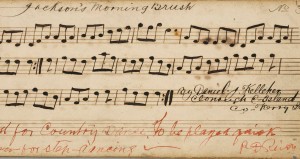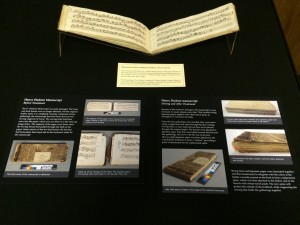Two Manuscripts in the O’Neill Collection
Posted on July 10, 2015 in Digital, Old Books, Special collections by Aedin
In 1931 Captain Francis O’Neill, one of the great collectors of Irish music, gave his library to the University of Notre Dame. O’Neill, born in County Cork in 1848, left Ireland in his teens and after some interesting years which included working as a sailor, settled into a career in the Chicago police force, becoming Chief of Police in 1901. Throughout his life his passion was Irish music, and he collected assiduously from Irish immigrants in the Chicago area. He also amassed a large collection of books on music and on Irish history, and these books, now in the Hesburgh Special Collections, show signs of his research in small pencil marks in the margins.
Many Irish dance tunes might have been lost but for the collections that O’Neill published. His collections are among the most important sources of Irish dance music.
In addition to the books, the Library received two manuscript books, each with an interesting provenance. The manuscripts were in poor condition, and have recently been taken to the Conservation Lab where conservator Sue Donovan stabilized bindings, carried out some mending and re-sewing, and returned them to the Rare Books Department in new custom-made cases.
They have also been digitally scanned, and may be viewed by clicking on the links below.

MSE 1435-B
P.D. Reidy Manuscript. [c1890]
Manuscript of Patrick Reidy, Professor of Dance.
The Dancing Master was popular in rural Ireland in the nineteenth century. Travelling dancing masters would stay some weeks in an area, and hold classes there. O’Neill devotes a chapter to the Dancing Master in his Irish Minstrels and Musicians (Chicago, 1913).
With the Irish peasantry dancing was a passion, hence the necessity for a teacher. On stated evenings during the winter, regardless of the condition of the roads, or the inclemency of the weather, a large company of aspirants for the skill, ranging in age from ten to forty years, would assemble in some roomy barn having a smooth hard floor of clay to be instructed in the salutatory art…
O’Neill 421
London in the 1890s had a large Irish population, and had its own branch of the Gaelic League by 1897, and when this branch eventually engaged a professional teacher for dance classes, they found Patrick Reidy, or Professor Reidy, a well-known dancing master from Kerry, living in Hackney, London.
It was Reidy who introduced and taught the group dances such as ‘The Siege of Ennis’ and ‘The Walls of Limerick’ which first became popular in London Gaelic League gatherings, then spread throughout England and into Ireland, through Gaelic League activities such as the 1901 Oireachtas in Dublin. Reidy was also one of the chief sources for the dances in A Handbook of Irish Dances (1902).
Our information on the manuscript in Captain O’Neill’s collection comes from O’Neill’s Irish Minstrels and Musicians. Apparently he and O’Neill were corresponding, and according to O’Neill, “the talented and kindly ‘Professor of Dancing, London and Castleisland,’ obligingly forwarded us a MS. book of music and a treatise from his own pen entitled: Dancing-Theory as It Should Be.”
This manuscript contains 37 pages of music, mostly dance tunes although there are some slow airs. A note on the source is often provided, with occasional additional comments such as that on the illustration above.
For more information on Patrick Reidy and the development of Irish céilí dancing, see Nicholas Carolan: The beginnings of ceili dancing: London in the 1890s. Dublin: Irish Traditional Music Archive, 2012. PDF: http://www.itma.ie/digitallibrary/book/beginnings-of-ceili-dancing/
MSE 1434-B
H. Hudson Manuscript [c.1841]
Manuscript of Henry Hudson of Dublin.
Henry Hudson (1798-1889) was a Dublin dentist and one of the early collectors of Irish songs and music. He collected and transcribed music and published selections, 106 melodies in all, in The Citizen or Dublin Monthly Magazine, of which he was musical editor from 1841 to 1843.
In a letter written to Charlotte Milligan Fox, dated July 28th, 1911, O’Neill explains that he purchased the Hudson manuscript volume through Nassau Massey of Cork. Of the other six manuscripts in Hudson’s collection, five are in Boston Public Library and one is in the National Library of Ireland.
O’Neill describes his volume as follows:
‘Vol. 3 – H. Hudson’ is strongly penned on the outside of the cover. On the inside of the front cover, and continued along the fly-leaf, is an index commencing with No. 243 and ending with 370, followed by the signature, ‘H. Hudson, 24 Stephen’s Green.’ The little volume is oblong, 9 by 3¾ inches.
Of the total number of tunes and airs –128—full fifty seem to have been taken from another numbered MSS. collection made by F. M. Bell, who credits them to Mrs. Foley, Margaret Foley, Mary Parker, and Margaret Kearney.
Others to whom H. Hudson acknowledges his indebtedness are James Barton, John Barton, John McFail, besides Simon Sullivan and Jack Piggott, pipers; also ‘Dublin Ballad-singer,’ Cocks’ ‘Encyclopædia of Melody,’ Walker’s ‘Hibernian magazine,’ and ‘Ordnance Survey of Londonderry.’
Perhaps the most interesting notation in the volume is: ‘The Maid of Sweet Gurteen,’ taken down by W. E. Hudson from singing of a little girl, Trassan (?) Street, six o’clock p.m., 9th December, 1840; and ‘Erin’s Lovely Home,’ taken down by W. E. Hudson, Naas, 17th December, 1840.
C. Milligan Fox “Concerning the William Elliott Hudson Collection of Irish Folk Songs” in the Journal of the Irish Folk Song Society, Vol. X (1912), pp. 5-9.








awesome!